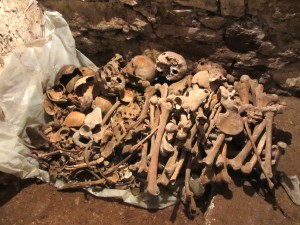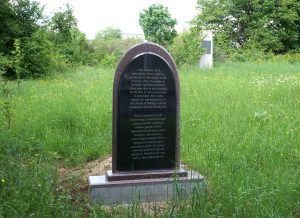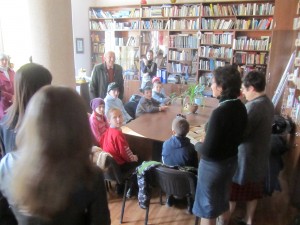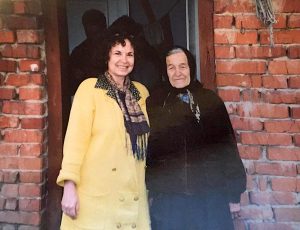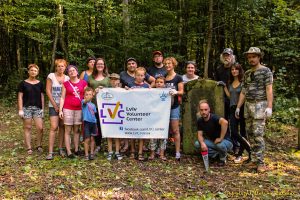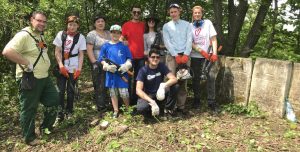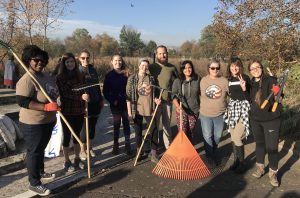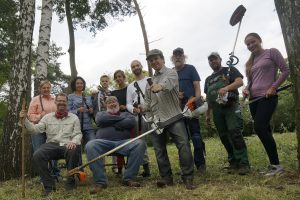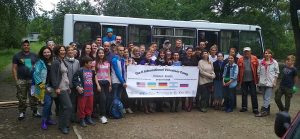![]() Ця сторінка також доступна українською.
Ця сторінка також доступна українською.
In addition to our proactive long-term heritage preservation and promotion projects described on other pages, from time to time Rohatyn Jewish Heritage has also taken on a few other, unanticipated issues which have heritage aspects. This page describes some of those ‘other projects’, which do not fit well into our existing project categories; the current status of the each project is noted in the headings below.
In general these other projects have arisen due to the almost complete devastation of the Jewish community of Rohatyn during World War II, and the absence of Jewish survivors in Rohatyn since the war. Although it is sometimes shocking when traces of the lost community surface, we must remain prepared to engage with any such evidence with respect and care.
Burial of Discovered Human Remains [Completed]
In a May 2012 news item, we reported that the skeletal remains of 12 humans, including men, women, and children, had been discovered during renovation work under the Ukrainian Greek Catholic church on the Rohatyn town square. We were advised of this find by retired teacher and local historian Mykhailo Vorobets, who had been contacted by the church because church leaders believed the bones likely belonged to Jews from the wartime ghetto directly behind the church. A preliminary forensic examination suggested the bones could date from that period. As the only representatives of Rohatyn’s Jews returning to Rohatyn frequently, we were asked how the church should proceed with burial of the remains.
This question proved difficult for the Rohatyn Jewish descendants group to resolve, partly due to uncertainty about the religious affiliation of the deceased, and partly out of concern and respect for the different burial customs of the UGC and Jewish faiths. More than a year passed without clear resolution, leaving the remains unburied.
Eventually we contacted Rabbi Kolesnik of Ivano-Frankivsk for advice, reported that discussion to Father Bihun of the Rohatyn Ukrainian Greek Catholic church, and then stepped back to let the two religious leaders arrange a solution. In the end, the bones were buried together in Rohatyn’s new Jewish cemetery, in a quiet service attended by representatives of both faiths, using a wooden casket built for the purpose by the church; it seemed to us a fitting and generous result.
Then in May 2015, a monument was raised over the grave to commemorate the unknown dead, and in gratitude to the religious leaders who brought the issue to a close. The monument expense was paid by a private donation with assistance from the Rohatyn city office cemeteries maintenance fund.
The Box of Jewish Papers [Completed]
We reported in June 2011 that the director of the Rohatyn internat (boarding school) had informed Mykhailo Vorobets of a surprising find during renovation work on the buildings of his school. The school complex includes a building which before World War II was a synagogue near the Ukrainian Greek Catholic church, and another building which was the Judenrat office during the war, at the edge of the wartime Jewish ghetto. During the summertime school renovation, workers had discovered a large number of paper scraps of all types, but most having some connection to the lost Jewish community of Rohatyn: letters, bills of sale, theater flyers, torah pieces, notes, and many other document fragments, in Hebrew, Yiddish, German, Polish, and Ukrainian. The scraps were gathered into a box; many were soiled from their years in the walls of the buildings, and quite a few had been chewed by rodents, yet the value of the scraps as evidence of the Jewish community was obvious.
The question was what to do with the papers; the internat director invited us to suggest a suitable future home for them. We photographed as many papers as we could, discussed the options after we left Rohatyn, and continued the discussion with the descendants’ group over the summer.
When we returned to Ukraine in autumn of 2011, we visited Rohatyn again in October and reviewed several options, giving a priority to ideas which would keep the papers in Ukraine near Rohatyn. The best temporary solution for all was for the internat to donate the box of papers to the Hesed-Arieh Jewish social charity and museum in Lviv. We paid a visit to Hesed-Arieh a week later, where the charity director and their museum manager quickly agreed to our proposal, and outlined what they could do to clean, scan, translate, document, and display the papers. In a happy conclusion to the issue, two weeks after that agreement the Rohatyn internat director visited Hesed-Arieh to donate the papers, bringing eight of his young students on the trip as an educational encounter, as fascinating for them as it was for us.
A very appropriate permanent home for the papers was created when the City of Rohatyn began development of its new local history museum, “Opillya”, which opened in November 2018. With agreement of the directors of both Hesed and the Rohatyn “Oplillya” museum, Rohatyn Jewish Heritage retrieved the paper scraps, documented each scrap with photographs, measurements, and descriptions, and then delivered the collection and its inventory to the museum for safekeeping and future study. We are very happy that these rare artifacts are now preserved in the city of their origin.
Researching and Recognizing Wartime Righteous Gentiles [Ongoing]

Rosette Faust with the Ukrainian family which had sheltered and fed her during the war. Source: Rosette Faust Halpern collection.
Reading post-war memoirs written by the rare survivors of Rohatyn’s wartime Jewish ghetto, and watching or listening to interviews with other survivors from the area, makes clear that saving a single Jewish life typically required the assistance of multiple “others” (gentiles, i.e. non-Jews) over the duration of the German occupation. For example, Jack Glotzer describes nine instances of life-saving aid from gentiles during his nearly thirteen months in the forests around Rohatyn after the liquidation of the Rohatyn ghetto. For their bravery to provide vital assistance to an oppressed people at a time when such aid was a capital offense, Israel’s official state memorial to the victims of the Holocaust, Yad Vashem, calls these people Khassidei Umot HaOlam, the Righteous Among the Nations. Yet only two of the many righteous people identified or described in Jewish memoirs and interviews about wartime Rohatyn and environs are publicly recognized by Yad Vashem.
The documentation requirements to meet Yad Vashem’s criteria for official recognition are difficult, and as the generation of Jews and gentiles which experienced the Holocaust first-hand fades, it becomes less and less likely that more righteous individuals will be recognized in the Avenue of the Righteous in Jerusalem. Nonetheless, Rohatyn Jewish Heritage believes that these people should not be forgotten, and where possible, they should be named and recognized for their deeds in other ways.
Since 2016, RJH has been researching and assembling details of wartime shelter and rescue stories from Jewish memoirs, interviews, and other sources which focus on the Rohatyn ghetto and the surrounding area. We learned as early as 2011 that retired teacher and local historian Mykhailo Vorobets had also been gathering information about the wartime experiences in the Rohatyn area from visiting Jewish survivors and from local Ukrainians whose parents, grandparents, or other family members had helped them. Our objectives in this work are to publicly name those otherwise unrecognized righteous people; where no names are known, to describe them as they were in memoirs in hopes that others can bring additional details; to assemble all of these stories of righteous action in the face of adversity in order to illustrate the special nature of this phenomenon; and, where possible, to bring together the families of these Jews and gentiles to share their common stories and bridge a divide of cultures and years.
We were honored to support one such meeting in 2017, and have used our connections to both the Jewish and non-Jewish Rohatyn communities to solicit previously untold stories. Our web page on this topic, and our promotion of the topic on Facebook, have given us multiple lines of communication with individuals around the world, bringing new information to several of the stories we have studied.
Read about the Rohatyn-region righteous people named and recognized to date.
This topic is important not only to revive this facet of wartime Rohatyn history, but also as a step toward dialogue between Jews and non-Jews about a difficult shared history. The director of the Rohatyn Opillya local history museum has proposed that we may work together to develop a temporary exhibition on this topic, which we are eager to support. The museum has also become a local contact point for others who may have letters, photographs, and other details to support the recognition of righteous individuals, and to identify by name some who are currently only known from episodes in Jewish memoirs.
To date, this project is managed entirely through volunteer effort by Rohatyn Jewish Heritage at zero cost to the NGO.
Volunteer Heritage Work at Other Sites Around the Region [Ongoing]
As is evident on many pages on our website and on social media, our work focuses on more than Rohatyn, and often but not only on Jewish history and heritage. We very much enjoy participating in volunteer events throughout western Ukraine and beyond, especially in eastern Galicia, with friends and colleagues associated with organizations which have been working for years in the region. We only occasionally report on these other events in our own news section, but frequently these “extracurricular” activities are popular features on our Facebook page, and sometimes in Ukrainian and foreign media; we summarize a few of them here.
In the city of Lviv and around its oblast, we frequently join the Lviv Volunteer Center (LVC) in projects they organize to clean, clear, and repair Jewish cemeteries and mass grave sites, synagogues and ruins, and in other local and international volunteer events. In addition to their several past volunteer days in Rohatyn, we have worked with the LVC every year since 2017, in Staryi Sambir, Ralivka, Boryslav, Drohobych, and Rudky, all in the Lviv oblast. In 2018 we joined them for several days in Lviv to support their flash rescue of Jewish headstones discovered under a residential street during utility repairs, heavy work which engaged a wide cross-section of Lviv citizens and visitors. Supporting the LVC in these projects benefits RJH also, as we learn from their leadership skills and their experience organizing large groups of volunteers. To reinforce the LVC’s cross-cultural commemoration efforts, we also join many of their ceremonies in the region, for example when a historical information plaque is installed or a heritage site is rededicated.
Volunteers in service with the Peace Corps in Ukraine have come to the aid of Rohatyn Jewish Heritage in nearly every year of our work, especially since 2017 when our active cemetery clearing work began, so we have been pleased to return the favor when we can. While we consider ways to support the volunteers assigned to Rohatyn schools, we are also happy to work further afield, for example in a large one-day Jewish cemetery clearing project organized by the PCV in Kalush in the Ivano-Frankivsk oblast in 2018, which also brought the LVC, local students, city staff, and many local citizens. We have also supported the PCV in their education leadership work, for example at a city-wide conference on the Holocaust held at a high school in Yavoriv in the Lviv oblast.
Our long association with The Matzevah Foundation (TMF) has also benefited us, both when they work with us in Ukraine and when we work with them in Poland. TMF provided a model for us in Jewish cemetery care, gave us hands-on experience with the typical range of hand and power tools for landscape maintenance, and provided very experienced guidance in the management of cross-cultural volunteer events. We were fortunate to work with them twice in Nasielsk and once in Oświęcim, and then we were very pleased to join hands with them in the old Jewish cemetery in Rohatyn. We continue to follow their work in Poland and to encourage others to support them.
In 2016, at the suggestion of our dear friend and frequent traveling companion Christian Herrmann, we joined a volunteer clearing effort in the huge Jewish cemetery of Chernivtsi in southwestern Ukraine (former Bukovina). With Christian’s guidance, international youth volunteer camps have been organized annually there by ASRP and the former SVIT-Ukraine; we joined the volunteers for a day of work and another touring the multi-ethnic history and heritage of Chernivtsi and its surrounding towns. As guidance for the future of our own work, this project was illuminating in that preparation and on-site management was provided by the young leaders themselves.
Rohatyn Jewish Heritage is proud to support our friends in all of these projects, to help them make a difference in communities across the region. Any expenses we incur in transport, lodging, meals, tools, etc. is borne by us personally, not by our NGO.

